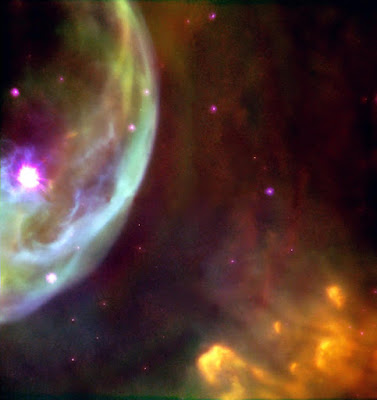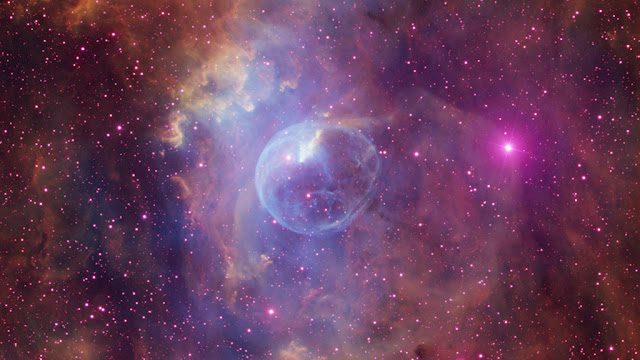About these NASA videos: Start by watching this short film which explains how Deep Space Extreme Deep Feld data is captured, photographed and made into videos.
Hubble: Galaxies Across Space and Time (2:52 minutes)
This award-winning short film transforms images and data from NASA's Hubble Space Telescope into a voyage that sweeps viewers across the universe and back into cosmic history.
The film opens with looming images of two mature galaxies that are relatively nearby Earth, and then pans through the vibrant and diverse panorama of thousands of galaxies in an image from the Great Observatories Origins Deep Survey.
The ensuing 3-D journey through these galaxies provides more than just a new perspective in space; it also takes the audience back in time.
Because light takes time to journey across space, the galaxies farther away from Earth are seen further back in cosmic history.
The virtual voyage reveals galaxies as they appeared billions of years ago, when they were still in the process of forming.
Originally released as an IMAX film, "Hubble: Galaxies Across Space and Time" was named "Best Short Film" of 2004 by the Large Format Cinema Association.
A production of the Office of Public Outreach at the Space Telescope Science Institute (STScI).
Flight Through Orion Nebula in Visible and Infrared Light (2 minutes)
This visualization explores the Orion Nebula using both visible-light observations from the Hubble Space Telescope and infrared-light observations from the Spitzer Space Telescope. The contrast between visible and infrared views of the nebula is examined using two spatially matched, three-dimensional models. As the camera flies into the star-forming region, the sequence cross-fades back and forth between the visible and infrared views.
Lagoon Nebula Zoom and Flythrough (2 minutes) This video zooms into the core of a rich star-birth region called the Lagoon Nebula, located in the constellation Sagittarius in the direction of our Milky Way galaxy’s central bulge.
Zoom-in to the Pleiades (13 seconds)
This video begins with a ground-based image of the Pleiades. It zooms into Merope, eventually settling on Hubble’s image of the reflection nebula that is being destroyed by the star’s radiation.
Vision Across the Full Spectrum: The Crab Nebula, from Radio to X-ray (1:12 minute)
The Crab Nebula (Messier 1) is the remnant of a supernova that exploded in the year 1054 AD. This mysterious “new star,” as early skywatchers called it, was observed around the world and most notably recorded by Chinese astronomers. The supernova was triggered when the progenitor star abruptly collapsed onto its iron core, and rebounded to expel most of its layers of gas into a blast wave. This wave is seen as an optical and infrared set of filaments that continues to impact surrounding material. This material was expelled from the dying red giant progenitor star 20,000 years prior to the supernova. The ultra-dense remnant core, called a neutron star, is crushed to the size of a city. Spinning furiously, the neutron star sends out twin beams of radiation, like a lighthouse. A lot of this energy comes from the neutron star’s intense magnetic fields. The initial radio image (from the Very Large Array Radio Telescope) shows the cool gas and dust blown out by the supernova winds. The infrared (Spitzer) image shows synchrotron radiation, an unusual form of light produced by electrons trapped in magnetic fields. The infrared image also shows hot gas. The visible-light image (Hubble) shows the detailed filamentary structure of the blast wave as it impacts the surrounding material. The ultraviolet image (XMM-Newton) shows hot, ionized gas. Finally, the X-ray emission (Chandra) from high-energy particles ejected from the pulsar shows the expanding nebula. The bipolar structure represents a powerful jet of material funneled along the neutron star’s spin axis.
Colliding Galaxies (48 seconds)
NGC 2207 is a pair of colliding spiral galaxies. Their bright central nuclei resemble a striking set of eyes. In visible light, trails of stars and gas trace out spiral arms, stretched by the tidal pull between the galaxies. When seen in infrared light (IR), the glow of warm dust appears. This dust is the raw material for the creation of new stars and planets. Complementary to the IR, the X-ray view reveals areas of active star formation and the birth of super star clusters. Though individual stars are too far apart to collide, the material between the stars merges to create high-density pockets of gas. These regions gravitationally collapse to trigger a firestorm of starbirth. The galaxy collision will go on for several millions of years, leaving the galaxies completely altered in terms of their shapes.
HH 901: Pillars in the Carina Nebula (36 seconds)
Herbig Haro 901 is an immense pillar of gas and dust inside the Carina Nebula, a huge star-forming region in our galaxy. The pillar is several light-years tall and contains a few massive young stars. They shoot out powerful jets that emerge from the cloud. In some cases, the jets create bow-shock patterns similar to the effects of a ship plowing through the ocean. In the visible-light view, very few stars can be seen because the gas and dust block starlight. But in the infrared view, stars become visible and numerous. The visible-light colors emerge from the glow of different gases: oxygen (blue), hydrogen/nitrogen (green), and sulfur (red). The Carina Nebula is approximately 7,500 light years from Earth.
Exploring Turbulent Space Around Earth (10 seconds)
Earth is surrounded by a protective magnetic environment — the magnetosphere — shown here in blue, which deflects a supersonic stream of charged particles from the Sun, known as the solar wind. As the particles flow around Earth’s magnetosphere, it forms a highly turbulent boundary layer called the magnetosheath, shown in yellow. Scientists, like those involved with NASA’s Magnetospheric Multiscale mission, are studying this turbulent region to help us learn more about our dynamic space environment.
Zoom in to Globular Star Cluster NGC 6397 (21 seconds)
This video zooms into a Hubble Space Telescope view of globular star cluster NGC 6397. This ancient stellar jewelry box, a globular cluster called NGC 6397, glitters with the light from hundreds of thousands of stars. The new measurement sets the cluster's distance at 7,800 light-years away, with just a 3 percent margin of error. NGC 6397 is one of the closest globular clusters to Earth.
Zoom Inside the Heart of the Trifid Nebula (26 seconds)
The video zooms into Hubble’s image of the heart of the Trifid Nebula. The zoom starts by looking at the Sagittarius constellation in the night sky and dissolves into the Lagoon Nebula. The video then goes deeper into the sky to show the Trifid Nebula, with the star birth region appearing as the final spectacular image.
Zoom into Spiral Galaxy M83 (50 seconds)
Zoom into an Infrared 3D Visualization of the Horsehead Nebula (53 seconds)
Hubble Extreme Deep Field Pushes Back Frontiers of Time and Space (2 minutes)
This video explains how astronomers meticulously assembled mankind's deepest view of the universe from combining Hubble Space Telescope exposures taken over the past decade.



















































